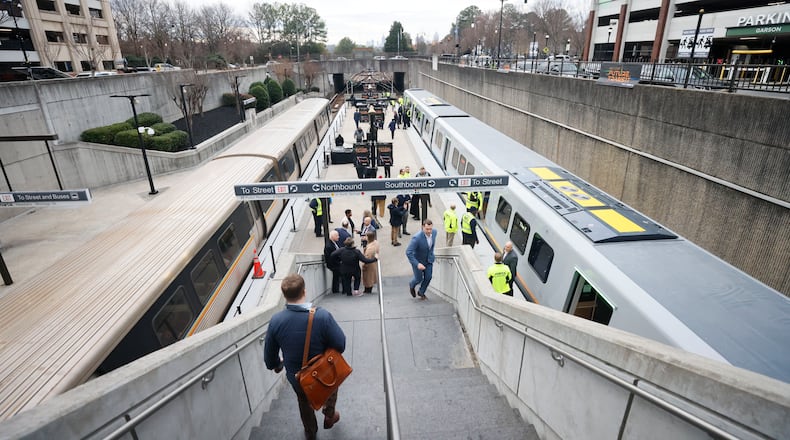MARTA was born from ambition. In the 1970s, MARTA’s founders dreamed boldly. They built a metro rail system longer than those in Rome, Prague or Amsterdam, and opened it just 7.5 years after voters approved funding. Their vision wasn’t just about moving people. They imagined “cities within the city” that would absorb one-third of future regional population growth in walkable communities at MARTA stations.
The 1971 MARTA Board included civic giants like Chick-fil-A founder Truett Cathy and African American business legend Jesse Hill Jr. who dreamed of growth without gridlock. But today, that dream is at risk.
MARTA now carries fewer riders than it did in the 1970s, when it operated solely as a bus system — before the 48-mile heavy rail metro was even built.
Fare revenue has plunged to 1995 levels despite three decades of inflation, population growth and system expansion. Annual operating losses have ballooned by $183 million since 2019, reaching $804 million. MARTA’s annual $1.6 billion budget may now be more than $100 million out of compliance with the MARTA Act and state law. If left unchecked, MARTA’s financial trajectory could trigger service cuts, further worsening congestion.
Still, I believe MARTA’s best chapter lies ahead.
MARTA is personal to me. I live in Midtown and ride it daily to my corporate job in DeKalb County. It connects me to this city that I love. As a Northern kid, I watched this Southern city host the world. Back then, MARTA carried about a million Olympic spectators a day. That same spirit can be reawakened.
I’ve worked in 10 countries transforming companies, cities and public agencies, and taken transit extensively across Asia and Latin America. I’ve seen what’s possible when organizations commit to excellence.
That’s why I’m sharing Back on Track 2025, a turnaround plan with 12 practical actions MARTA’s board can take to stabilize finances, win back riders and rebuild a culture of excellence.
The plan starts by restoring the basics:
Fix mission control: Set an inspiring, measurable goal. Launch strategic initiatives to achieve the goal. Rebuild the agency’s culture around performance and excellence.
Win back riders: Invest in safety, marketing and accelerate the long-delayed bus network redesign which is now three years behind schedule.
Build the team: Become an employer that attracts, retains and develops top talent in operations, engineering and leadership.
But managerial improvements alone won’t fix MARTA’s trajectory. The agency needs a new business model, one that doesn’t rely almost entirely on fares and tax dollars.
Top-performing metro systems like Tokyo Metro and Hong Kong MTR leverage real estate and commercial subsidiaries to drive revenue and reinvest in transportation and housing. It’s time for MARTA to stop thinking like a bureaucracy and start acting like a city-building enterprise. To generate resilient sources of ridership and revenue, MARTA must adopt the portfolio growth model proved by leading Asian metros, establishing at least three new entities:
MARTA Real Estate Inc.: A for-profit subsidiary that transforms parking lots and underused land, building thriving station neighborhoods from North Springs to South DeKalb.
MARTA Events Inc.: A revenue engine that fills empty station parking lots with concerts, festivals and markets, pumping energy, ridership and dollars into the system.
MARTA.org Foundation: A philanthropic arm that can raise millions to support equity, innovation and community impact, just as the Atlanta Beltline Partnership has done.
This isn’t theory. It’s a proven playbook from the world’s best metro systems.
Change won’t be easy. But it’s overdue.
Even UPS CEO Carol Tomé sounded the alarm on MARTA’s recent performance, saying: “The data, any way you cut it, is not good. That’s concerning to us. The quality of life is being stuck in the roads and the quality of air being stuck on the roads.” She called on Atlanta to aspire to a “best-in-class” metro system.
If you were running Delta, Coca-Cola or Home Depot and saw metrics like MARTA’s — declining revenue, rising losses, customer dissatisfaction — you wouldn’t double down on the status quo. You’d act boldly.
MARTA’s board now faces a choice: Manage decline or lead a renaissance. The MARTA board should adopt Back on Track 2025 as its formal turnaround road map by Aug. 1.
Back on Track 2025 is rooted in MARTA’s founding vision, global best practices and sound business strategy. But above all, it’s a rallying cry.
It says to every rider, taxpayer and voter: You deserve better. You deserve a metro system that works, that grows and that earns your trust.
Atlanta is rising. MARTA must rise with her.
Credit: contributed
Credit: contributed
Douglas Nagy is an Atlanta resident and MARTA rider. He is former deputy commissioner at the city of Atlanta Department of Transportation. Nagy now works for the private sector and is a transportation and travel executive with more than 20 years experience leading complex transformations across cities, companies and public agencies.
About the Author
Keep Reading
The Latest
Featured



